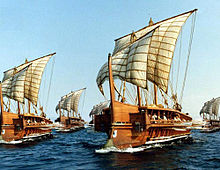|
Greek city of
Thessalonica in
Macedonia
Bronze 19mm (9.33 grams) Struck circa 187-167 B.C.
Reference: SNG ANS 798-9 corr. (Zeus!) var. VERY RARE
Diademed head of Poseidon right, trident over shoulder.
ΘEΣΣA / ΛONI above and below prow of galley right.
You are bidding on the exact item pictured,
provided with a Certificate of Authenticity and Lifetime Guarantee of
Authenticity.

Poseidon
is one of the twelve
Olympian deities
of the
pantheon
in
Greek mythology
. His main domain is the
ocean
, and he is called the “God of the Sea”.
Additionally, he is referred to as “Earth-Shaker” due to his role in causing
earthquakes
, and has been called the “tamer of
horses”. He is usually depicted as an older male with curly hair and beard.
The name of the sea-god
Nethuns
in
Etruscan
was adopted in Latin for
Neptune
in
Roman mythology
; both were sea gods analogous
to Poseidon. Linear B
tablets show that Poseidon was
venerated at Pylos
and
Thebes
in pre-Olympian
Bronze Age Greece
as a chief deity, but he was
integrated into the
Olympian gods
as the brother of
Zeus and Hades
. According to some folklore, he was saved
by his mother Rhea, who concealed him among a flock of lambs and pretended to
have given birth to a colt, which was devoured by Cronos.
There is a
Homeric hymn
to Poseidon, who was the protector
of many Hellenic cities, although he lost the contest for
Athens
to
Athena
. According to the references from
Plato
in his dialogue Timaeus and Critias,
the island of Atlantis
was the chosen domain of Poseidon.

A
galley is a type of
ship propelled by
rowers
that originated in the eastern
Mediterranean Sea
and was used for
warfare
,
trade
and
piracy
from the first millennium BC. Galleys
dominated
naval warfare
in the Mediterranean from the 8th
century BC until development of advanced sailing warships in the 17th century.
Galleys fought in the wars of
Assyria
, ancient
Phoenicia
,
Greece
,
Carthage
and
Rome
until the 4th century AD. After the fall
of the
Western Roman Empire
galleys formed the
mainstay of the
Byzantine navy
and other navies of successors
of the Roman Empire, as well as new
Muslim
navies. Medieval Mediterranean states,
notably the Italian maritime republics, including
Venice
,
Pisa
,
Genoa
and the
Ottoman Empire
relied on them as the primary
warships of their fleets until the 17th century, when they were gradually
replaced by sailing warships. Galleys continued to be applied in minor roles in
the Mediterranean and the
Baltic Sea
even after the introduction of
steam propelled
ships in the early 19th
century.
The galley engagements at
Actium
and
Lepanto
are among the greatest
naval battles
in history.
<=”” span=””>
The city Thessalonica in Macedonia
was founded around
315 BC
by the
King
Cassander of Macedon
, on or near the site of the ancient town of
Therma
and
twenty-six other local villages. He named it after his wife
Thessalonike
, a half-sister of
Alexander the Great
. She gained her name (“victory of Thessalians”: Gk
nikē
“victory”) from her father,
Philip II
, to commemorate her birth on the day of his gaining a victory over
the
Phocians
, who were defeated with the help of
Thessalian
horsemen, the best in Greece at that time. Thessaloniki developed
rapidly and as early as the
2nd
century BC
the first walls were built, forming a large square. It was an
autonomous part of the Kingdom of
Macedon
, with its own parliament where the King was represented and could
interfere in the city’s domestic affairs.
Roman
era
After the fall of the kingdom of Macedon in
168 BC
,
Thessalonica became a city of the
Roman Republic
. It grew to be an important trade-hub located on the
Via
Egnatia
, the
Roman road
connecting
Byzantium
(later
Constantinople
), with
Dyrrhachium
(now Durrës
in
Albania
), and
facilitating trade between Europe and Asia. The city became the capital of one
of the four Roman districts of Macedonia; it kept its privileges but was ruled
by a praetor
and had a Roman garrison, while for a short time in the
1st
century BC
, all the Greek provinces came under Thessalonica (the Latin form
of the name). Due to the city’s key commercial importance, a spacious harbour
was built by the Romans, the famous Burrowed Harbour (Σκαπτός Λιμήν) that
accommodated the town’s trade up to the eighteenth century; later, with the help
of silt deposits from the river
Axios
, it was
reclaimed as land and the port built beyond it. Remnants of the old harbour’s
docks can be found in the present day under Odos Frangon Street, near the
Catholic Church.
Thessaloniki’s
acropolis
,
located in the northern hills, was built in
55 BC
after
Thracian
raids in the city’s outskirts, for security reasons.
The city had a
Jewish
colony, established during the
first
century
, and was to be an early centre of
Christianity
. On his second missionary journey,
Paul
of Tarsus
, born a Hellenized Israelite, preached in the city’s synagogue,
the chief synagogue of the Jews in that part of Thessaloniki, and laid the
foundations of a church. Other Jews opposed to Paul drove him from the city, and
he fled to
Veroia
. Paul wrote two of his
epistles
to the Christian community at Thessalonica, the
First Epistle to the Thessalonians
and the
Second Epistle to the Thessalonians
.
Thessaloníki acquired a patron saint,
St. Demetrius
, in 306. He is credited with a number of miracles that saved
the city, and was the Roman
Proconsul
of Greece under the anti-Christian emperor
Maximian
,
later martyred at a Roman prison where today lies the
Church of St. Demetrius
, first built by the Roman sub-prefect of
Illyricum
Leontios in 463. Other important remains from this period include
the
Arch and Tomb of Galerius
, located near the centre of the modern city.
|











